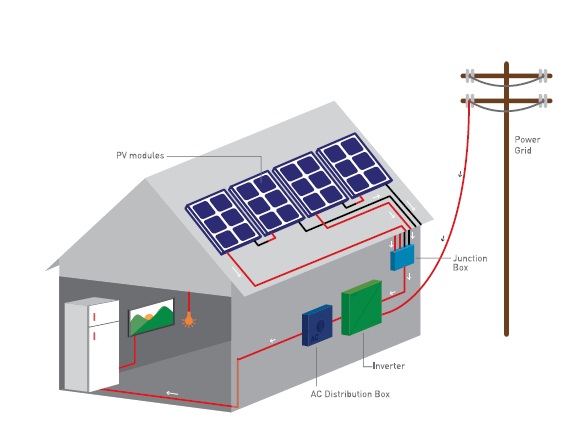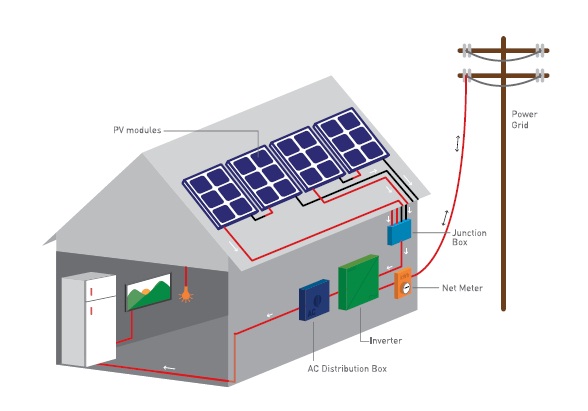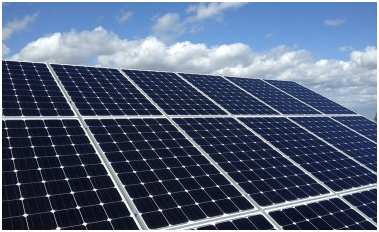Solar Roof Top
Solar Roof Top
Rising cost of Electricity makes today the best time to invest in KW Rooftop Systems. Be an Independent power producer, not only does a system pay itself off via Subsidies and lower, or No electricity bills, your investment in iSolar Pro™ systems further attracts Tax Benefits for a commercial establishment.
A standard kW system installation is affordable for almost anyone to get started on a Greener, Cleaner and Cheaper way forward. Installing a solar power KW system will instantly add to the value of your residential or commercial establishment. Your most Profitable investment ever !
Rooftop solar PV systems
This section deals with the overview of a solar PV system, working of a PV
system, different components, their sizing and connections. Further, we have
analysed relevance of storage in PV systems, the importance of net metering
and the typical PV system sizes across different consumer segments.
Functioning of a PV system
A solar PV power plant converts sunlight into electricity. It does so without any moving parts (unless it has a tracking system) and without generating either noise or pollution. A solar PV system can be installed at any un-shaded location such as on rooftops of buildings, car parking sheds, empty land, or even on top of canals and roads. Typical system sizes range from 240 watts to 100 MW. There is very little difference in the technical design between
small kW-sized plants (typically de-centralized, off-grid) and large, MW-sized plants (typically centralized, grid-connected). Solar plants can easily be scaled using independent, modular components such as PV modules, inverters and batteries. The rooftops of buildings would be ideal for the installation of solar PV in City A typical rooftop solar
PV system for a household is between 1-10kW. For larger buildings, such as offices or malls, it can reach 100 kW or more. Given Gujarat’s average irradiation of 5-5.5 kWh/m2/day, a kW of installed solar PV can generate 4-4.5 kWh of power during daylight hours, equivalent to the amount of power needed for a refrigerator to run for a day. A solar PV system consists of the following key components
- Solar PV array (group of modules)
- Solar inverter
- Battery
- Interconnecting devices (junction box, cables, distribution box)
The PV array consists of solar modules interconnected with each other. The modules convert the energy from unlight, are held on structures made of galvanized iron, mild steel or aluminum and are inclined at a horizontal tilt,
facing either south or east-west.
Types of rooftop solar PV systems
Rooftop solar PV systems are of 3 types:
- Grid-tied – These rooftop systems are primarily designed to supply the generated power to the grid and also power the load. These systems will NOT generate power during a power failure as the inverter shuts down the system to stop sending power into the grid and avoids the risk of electrocuting utility personnel who are working to repair the grid
- Grid-interactive – This system works in conjunction with either a battery backup or diesel generator to support the load even during a power failure.
- Off-grid – This system does not work with the grid and is designed to work only with a battery backup or diesel generator in off-grid applications
The difference between the systems lies in the kind of inverter used, and the inclusion of batteries. As various vendors use different terminology for these systems we urge you to verify the functions of the offered system rather than going by the name alone.
Component cost of rooftop PV systems
A rooftop solar PV system costs approximately Rs. 1,00,000 per kWp (kilowatt peak) including installation charges but without batteries and without considering incentives
Rooftop and high efficiency solar modules
High efficiency solar panels are coming in to their own at the moment. Many of the most efficient solar modules have a copper foundation, which makes them especially resistant to corrosion. Solar cell manufacturers are also swapping the weak connections in their cells with sturdier, thicker connectors. In the past, with these weak connections, if just one connection failed then that would mean that the whole cell was out of action. Present day solar cell connectors are much more resistant to failure, and also the loss of one connector does not have such a drastic effect on the rest of the cell. These new connectors are also designed to expand and contract in line with changes in temperature and sunlight levels throughout the day.
Technical Specification
Technical Specification
| Model | iSolar-300 PP | iSolar-500 PP | iSolar-800 PP | iSolar-1000 PP | iSolar-2000 PP |
| Application | Home Small Shop | Home Small Shop | Home Small Shop | Home Small Shop Small Office | Home Office Dispensary |
| Loads (AC) | |||||
| CFL Lights, 25W | 3 | 4 | 6 | 8 | 8 |
| Fans, 70W | 1 | 3 | 4 | 4 | 6 |
| TV PC, 150W | 1 | 2 | |||
| Printer | 1 | 2 | |||
| Fridge, 300W | 1 | ||||
| AC 1 .5 TR 1.5 Hp Motor | |||||
| Maximum Load | 240 Watts | 390 Watts | 625 Watts | 780 Watts | 1560 Watts |
| PV Modules | 300 Watts | 500 Watts | 800 Watts | 1000 Watts | 2000 Watts |
| PCU 230V AC | 300VA | 50OVA | 800VA | 1000VA | 2000 VA |
| Baflefyl 12 V | 1*100Ah | 1*150Ah | 2*100Ah | 2*150Ah | 4*15OAh |
Better? Believe It.
Not all solar is the same. The performance and longevity of your system depends on the technology you choose.
iSolar Pro™ manufactures Water Heater & panels with the highest energy production and unmatched reliability. Our iSolarpro™ cell technology is designed by Green Planet Tech





